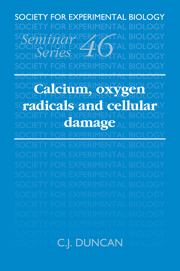Book contents
- Frontmatter
- Contents
- List of Contributors
- Preface
- 1 Are there common biochemical pathways in cell damage and cell death?
- 2 Free radicals in the pathogenesis of tissue damage
- 3 Calcium and signal transduction in oxidative cell damage
- 4 Regulation of neutrophil oxidant production
- 5 Reperfusion arrhythmias: role of oxidant stress
- 6 Biochemical pathways that lead to the release of cytosolic proteins in the perfused rat heart
- 7 Malignant hyperthermia: the roles of free radicals and calcium?
- 8 Free radicals, calcium and damage in dystrophic and normal skeletal muscle
- 9 Ultrastructural changes in mitochondria during rapid damage triggered by calcium
- 10 The importance of oxygen free radicals, iron and calcium in renal ischaemia
- 11 The Rubicon Hypothesis: a quantal framework for understanding the molecular pathway of cell activation and injury
- Index
3 - Calcium and signal transduction in oxidative cell damage
Published online by Cambridge University Press: 18 January 2010
- Frontmatter
- Contents
- List of Contributors
- Preface
- 1 Are there common biochemical pathways in cell damage and cell death?
- 2 Free radicals in the pathogenesis of tissue damage
- 3 Calcium and signal transduction in oxidative cell damage
- 4 Regulation of neutrophil oxidant production
- 5 Reperfusion arrhythmias: role of oxidant stress
- 6 Biochemical pathways that lead to the release of cytosolic proteins in the perfused rat heart
- 7 Malignant hyperthermia: the roles of free radicals and calcium?
- 8 Free radicals, calcium and damage in dystrophic and normal skeletal muscle
- 9 Ultrastructural changes in mitochondria during rapid damage triggered by calcium
- 10 The importance of oxygen free radicals, iron and calcium in renal ischaemia
- 11 The Rubicon Hypothesis: a quantal framework for understanding the molecular pathway of cell activation and injury
- Index
Summary
Introduction
In aerobically growing eukaryotic cells, ATP synthesis is coupled to the enzymatic reduction of molecular oxygen (O2) to H2O via a sequential, four-electron transfer reaction. However, one- and two-electron reduction of O2 can also occur under physiological conditions in mitochondria and other cellular compartments, generating superoxide anion free radicals (O2−) and other active oxygen species, including hydrogen peroxide (H2O2) and the hydroxyl radical (OH) (Fridovich, 1983). Although several intracellular mechanisms exist that normally prevent the accumulation of active oxygen species during cell metabolism, these protective systems can become overwhelmed and toxic damage to cells may follow. Thus, accumulating evidence implicates oxygen radicals and other oxygen-derived species as causative agents in ageing and a variety of human diseases, including cancer (Cerutti, 1985).
The term ‘oxidative stress’ is generally applied to conditions in which the intracellular prooxidant–antioxidant ratio favours the former (Sies, 1985). Recent studies by our laboratory and others have examined the effects of oxidative stress on various cellular functions. Experimental systems commonly used to expose various types of cells and tissues to oxidative stress include enzymatic generation of active oxygen species (e.g. using xanthine/xanthine oxidase) (Muehlematter, Larsson & Cerutti, 1988), direct exposure to peroxides or prooxidants (Sies, Brigelius & Graf, 1987) and intracellular generation of active oxygen species by treatment with redox-cycling chemicals such as quinones or bipyridilium compounds (Smith et al., 1985; Orrenius et al., 1986).
- Type
- Chapter
- Information
- Calcium, Oxygen Radicals and Cellular Damage , pp. 17 - 34Publisher: Cambridge University PressPrint publication year: 1991
- 2
- Cited by

